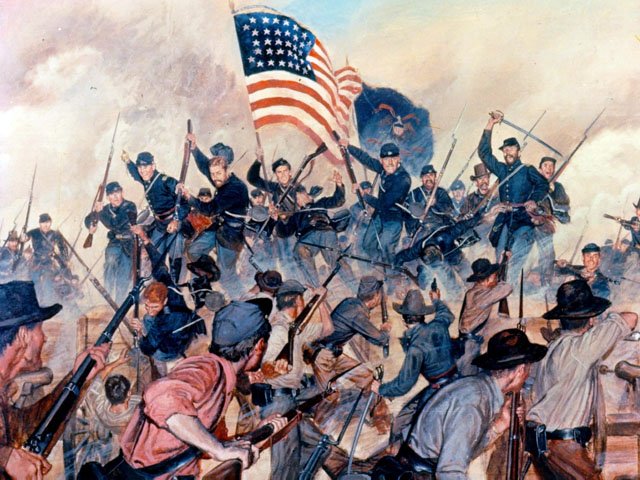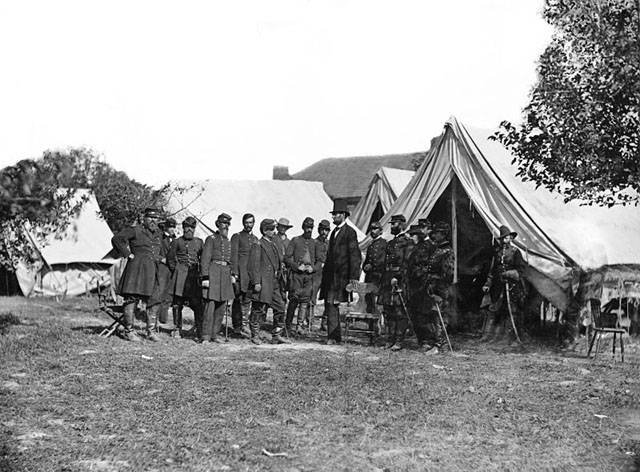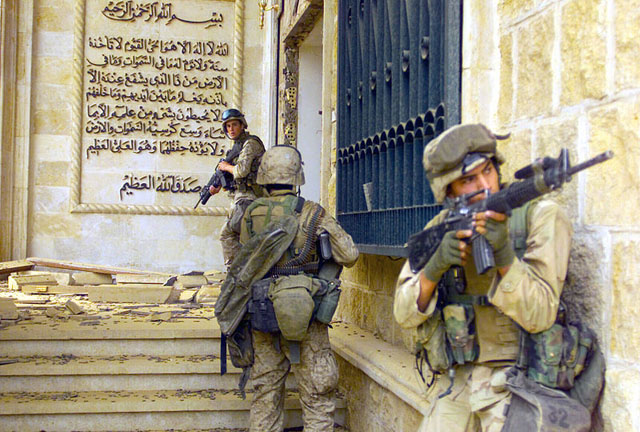
America the Brave: A Selection of Veterans Day Images

This post was originally published on Veterans Day 2008, and has proven to be one of my more popular entries. So I’m bringing it back as my small tribute for this year.
Originally known as Armistice Day, the first Veterans Day was celebrated on November 11, 1938 — the 20th anniversary of the effective end of World War I. Starting in 1954 the scope of the holiday was expanded to commemorate all those who had fought and served for the United States.
I don’t have any stirring essays in me, so my small tribute to our armed forces is this collection of images portraying the history of major American military conflict. Thank you all for your service!
American Revolutionary War (1775–1783)

The Battle of Trenton (December 26, 1776) was a turning point in the American Revolution, as General George Washington led his demoralized troops across the Delaware River and captured 1,000 Hessian soldiers. Washington and his soldiers followed up that surprise attack with another victory a week later in Princeton.

The vaunted British Royal Navy suffered a stunning defeat at the hands of the much younger and smaller U.S. Navy on August 19, 1812 when the USS Constitution bested the HMS Guerriere after a 35-minute battle. A year later the American defense of Fort McHenry in Baltimore inspired lawyer Francis Scott Key to compose the poem that became the basis for “The Star-Spangled Banner.”

The Mexican-American War was a politically contentious issue, although it did vastly increase both the size of the U.S. Army and the United States itself. The Battle of Monterrey (September 21-24, 1846) was fought effectively to a stalemate, although a two-month armistice agreement signed between General Pedro de Ampudia (Mexico) and General Zachary Taylor (United States) saw the Mexican Army surrender the city of Monterrey.

Pred. Lincoln with Maj. Gen. McClellan and staff at the Grove Farm after the Battle of Antietam – October 3, 1862.
The Battle of Antietam (September 17, 1862) was the first major engagement of the Civil War to take place on Northern soil. Approximately 23,000 soldiers died that day, making it the single bloodiest day in American combat history. This photo shows President Abraham Lincoln visiting the battlefield on October 3.

Theodore Roosevelt and the Rough Riders atop San Juan Hill, July 1898.
The Spanish-American War lasted for just over 100 days (April-August 1898) and is remembered mainly for two things — the controversial destruction of the USS Maine (which became a major pretext for the war) and the rise to fame of Theodore Roosevelt’s Rough Riders. Roosevelt rode a wave of popularity first to the governorship of New York (elected in November 1898) and then the White House (elected as William McKinley’s Vice President in 1900).

American tanks going forward to the battle line in the Forest of Argonne, France – September 26, 1918.
Despite a firm and official policy of isolationism during the first few years of World War I, U.S. President Woodrow Wilson could no longer ignore German aggression and Congress finally declared war on April 6, 1917. The Germans were convinced that it would take at least 18 months before America could muster enough forces to make an impact, and hoped to win the war in the interim. By the summer of 1918, however, 10,000 Americans were arriving in France daily.

African-American troops of a field artillery battery set up a 155mm howitzer in France (June 28, 1944).
Without question, World War II was our finest hour as a fighting nation since the American Revolution. As with World War I, the U.S. resisted involvement at first but eventually relented. This time the turning point was not a German act of hostility, but the Japanese attack at Pearl Harbor on December 7, 1941. During the war more than 16 million Americans served in the military, with 290,000 killed in action and 670,000 wounded.

Supporting the 8th ROK Army Division, a Sherman tank fires its 76 mm gun at KPA bunkers at “Napalm Ridge”, Korea, May 11, 1952.
It’s difficult to understand how a war that resulted in so many casualties was so easily forgotten in this country, but that seems to be the case for the Korean War. Although the Koreans and Chinese suffered the most casualties, it is still important to remember that more than 36,000 Americans died and nearly 100,000 were wounded in the conflict.
Sadder still is that after all those deaths, the war is technically not even over. North and South Korea have never signed a peace treaty, and have been under a tentative cease fire agreement for more than half a century.

U.S. Paratroopers of the 173rd Airborne Brigade First Battalion rush a wounded soldier into an ambulance helicopter on June 29, 1965 during the Vietnam War.
I’ve spent a lot of time learning about the background and conduct of the Vietnam War, as well as debating whether we should have fought it in the first place. Certainly no war in our nation’s history — save the Civil War — has so sharply divided this country. But for at least one day I will put all that aside to remember the nearly 60,000 U.S. dead, 2,000 missing, and 300,000+ wounded. You will never be forgotten!

USAF aircraft of the 335th Fighter Squadron (F-16, F-15C and F-15E) fly over Kuwaiti oil fires set by the retreating Iraqi army during Operation Desert Storm in 1991.
In many ways, the first Gulf War (aka Operation Desert Storm) is still being fought, as many of the veterans from that war still suffer today. Speaking of which…

U.S. Marines entering one of Saddam Hussein’s palaces during Operation Iraqi Freedom, 2003.
Not since the Vietnam War has American military involvement been so controversial at home and around the world as with our 2003 invasion of Iraq. It will be years, however, before the long-term ramifications of the war will be known.

U.S. Marine Corps Sergeant Kevin Healy exits an Italian Army CH-47 Chinook helicopter, November 2008.
Most recently the eyes of the nation were on our fighting men and women serving in Afghanistan. Our invasion of that nation (code named Operation Enduring Freedom) was prompted mainly by the terrorist attacks of September 11, 2001, and had the initial goal of dismantling al-Qaeda and removing the Taliban from power. At 13 years this was the longest war in U.S. military history.
Thank you, veterans!
(watch this video for Veterans Day 2010, produced by the U.S. Department of Veteran Affairs)
People found this post by searching for:
- "vietnam war", "gulf war", "world war 1", "battle of trenton", "vietnam war pictures", "World war one", "Korean War", "the gulf war"